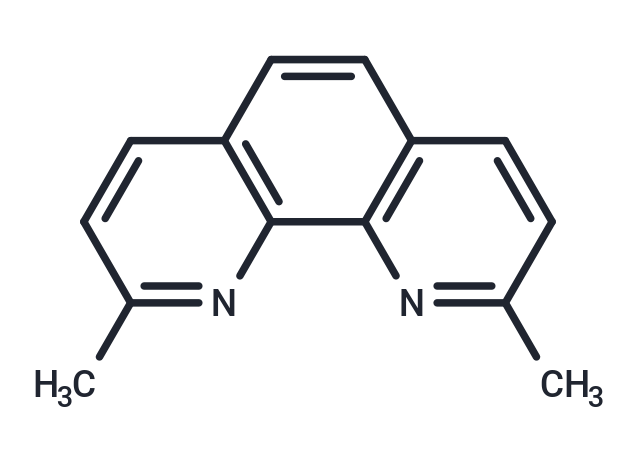Shopping Cart
- Remove All
 Your shopping cart is currently empty
Your shopping cart is currently empty

Neocuproine is a copper(I) chelator that enhances the purinergic component of vasoconstriction induced by electric field stimulation, and is often used as a ligand reagent and copper ion detector.Neocuproine forms stable complexes with copper ions and can play a catalytic role in certain chemical reactions and analytical methods.Neocuproine acts as a redox-active on the iron and cobalt ligand platform for protection against oxidative damage in NSC34 cells.

| Pack Size | Price | Availability | Quantity |
|---|---|---|---|
| 5 g | $29 | In Stock |
| Description | Neocuproine is a copper(I) chelator that enhances the purinergic component of vasoconstriction induced by electric field stimulation, and is often used as a ligand reagent and copper ion detector.Neocuproine forms stable complexes with copper ions and can play a catalytic role in certain chemical reactions and analytical methods.Neocuproine acts as a redox-active on the iron and cobalt ligand platform for protection against oxidative damage in NSC34 cells. |
| In vitro | Neocuproine (100 lM) generally inhibits the production of inflammatory mediators.[2] Neocuproine treatment reduced IFN-γ, MCP-1, MCP-3, and VEGF-A levels. The production of KC/GRO was downregulated by neocuproine deficiency.[2] Neocuproine, but not ATP7A deficiency, reduced the production of FGF-9, IL-1α, IL-12p70, IL-2, IL-3, IL-4, IL-6, MIP-1β, MIP-2, RANTES, and TNFα.[2] |
| In vivo | Neocuproine (100 microM) significantly suppressed the amplitude and frequency of the spontaneous contractions in the ovariectomized non-pregnant rat uterus while this agent facilitated the frequency of the spontaneous or oxytocin-induced contractions in the pregnant rat and human uterus without altering the amplitude of these contractions.[3] Neocuproine (200 microM) could enhance the amplitude of the contractions in the pregnant uterus. These effects were blocked by a purinergic receptor antagonist, suramin (100 microM) and did not occur following the administration of neocuproine-copper(I) complex or copper(II) chelator cuprizone. alpha, beta-methylene ATP increased the amplitude and frequency of contractions in the pregnant uterus, but not affected the contractions in the ovariectomized non-pregnant rat uterus, and neocuproine potentiated this facilitation effect.[3] |
| Alias | Neocuproin |
| Molecular Weight | 208.26 |
| Formula | C14H12N2 |
| Cas No. | 484-11-7 |
| Smiles | Cc1ccc2ccc3ccc(C)nc3c2n1 |
| Relative Density. | 1.178 g/cm3 |
| Storage | keep away from direct sunlight,keep away from moisture | Powder: -20°C for 3 years | In solvent: -80°C for 1 year | Shipping with blue ice. | |||||||||||||||||||||||||||||||||||
| Solubility Information | DMSO: 70 mg/mL (336.12 mM), Sonication is recommended. | |||||||||||||||||||||||||||||||||||
Solution Preparation Table | ||||||||||||||||||||||||||||||||||||
DMSO
| ||||||||||||||||||||||||||||||||||||

Copyright © 2015-2025 TargetMol Chemicals Inc. All Rights Reserved.